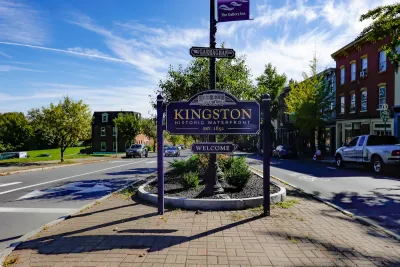Kingston recently adopted a form-based code, taking the rare step to entirely replace its old zoning code with form-based standards while also repealing parking requirements and allowing accessory dwelling units and missing middle housing.

The city of Kingston, New York, located north of New York City along the Hudson River, adopted a new form-based code earlier this month. According to local news reports, the form-based code is intended to mitigate the growing cost of housing in the city by allowing accessory dwelling units and new opportunities for infill development.
According to an article by Phillip Pantuso, Kingston’s new code is notable for replacing its entire zoning code with a new form-based code—most cities who have applied form-based codes do so only in certain nieghborhoods or along specific streets.
“The new zoning code was developed over a three-year period with the consulting firm Dover, Kohl & Partners and included regular community input organized in part by the local advocacy group Kingston Code Reform Advocates,” reports Pantuso.
Among the changes accomplished by Kingston’s new form-based zoning code are the end of minimum parking requirements, the legalization of missing middle housing, corner stores, and accessory dwelling units, and a new, “streamlined” development approval process.
Here is how Pantuso describes form-based codes:
Form-based codes address the relationship between building facades and public space, the form and mass of buildings in relation to one another, and the scale and types of streets and blocks, according to the Form-Based Codes Institute, a nonprofit focused on creating healthy communities. The goal is to emphasize creating cohesive and visually appealing communities that promote walkability and mixed-use development.
FULL STORY: Kingston passes form-based zoning code to aid affordable housing

National Parks Layoffs Will Cause Communities to Lose Billions
Thousands of essential park workers were laid off this week, just before the busy spring break season.

Retro-silient?: America’s First “Eco-burb,” The Woodlands Turns 50
A master-planned community north of Houston offers lessons on green infrastructure and resilient design, but falls short of its founder’s lofty affordability and walkability goals.

Delivering for America Plan Will Downgrade Mail Service in at Least 49.5 Percent of Zip Codes
Republican and Democrat lawmakers criticize the plan for its disproportionate negative impact on rural communities.

Test News Post 1
This is a summary

Test News Headline 46
Test for the image on the front page.

Balancing Bombs and Butterflies: How the National Guard Protects a Rare Species
The National Guard at Fort Indiantown Gap uses GIS technology and land management strategies to balance military training with conservation efforts, ensuring the survival of the rare eastern regal fritillary butterfly.
Urban Design for Planners 1: Software Tools
This six-course series explores essential urban design concepts using open source software and equips planners with the tools they need to participate fully in the urban design process.
Planning for Universal Design
Learn the tools for implementing Universal Design in planning regulations.
EMC Planning Group, Inc.
Planetizen
Planetizen
Mpact (formerly Rail~Volution)
Great Falls Development Authority, Inc.
HUDs Office of Policy Development and Research
NYU Wagner Graduate School of Public Service





























